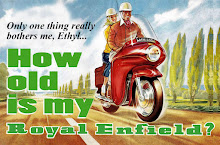If you set up a Google Alert for "Royal Enfield," as I have, you'll get a fast education in current speech.
For instance, the headline "Royal Enfield drops limited edition," doesn't mean Royal Enfield is discontinuing a model. It means the opposite: Royal Enfield is introducing a limited edition version of its motorcycles.
"Drop" now has several meanings, including the opposite of "drop."
You probably knew that.
But did you know that a Royal Enfield motorcycle described as having a "Dangerous Engine" is not a menace, except in so far as it has a "powerful engine"?
Other oddities include variations on a headline that has been appearing around the internet for months:
"Do you know how much a Royal Enfield Bullet 350 cost back in 1986? You will not believe your eyes."
The headline is based on a 1986 invoice for a Royal Enfield Bullet in India, compared to what a Bullet costs today in India.
The implication is that you'll be wowed by how much the Bullet has gone up in price.
It hasn't.
What has happened is that India's rupee has gone down in value. Adjusted for inflation a new Bullet is effectively about the same price it was in 1986.
Who could resist clicking on such an interesting link? And, as long as we keep clicking, the invoice will continue to be discovered over and over again.
It's like that ad that claims to explain why you should put a plastic water bottle on your tire when you park your car.
Anyone watching for internet references to "Royal Enfield" quickly learns that the vast majority of stories online come out of India, where Royal Enfield is respected and far more prominent than it is in the United States.
So a headline that claims "Royal Enfield Bullet 350 Come With Super Engine Like Monster With Killer Look," makes sense in India, but certainly not in North America.
This is an article about a normal 350 Bullet with a look that has not been killing anybody since it was introduced, in 1955. It is no "monster" motorcycle.
Finally there are the articles that gleefully announce that Royal Enfield plans to introduce a modern 250cc motorcycle.
It may be that Royal Enfield plans to introduce a 250cc motorcycle in India. Supposedly the company has confirmed this, and Royal Enfield has, in its long history, produced 250cc motorcycles before.
But I begin to wonder, when so many articles about this include so much speculation, regurgitating the few details reported elsewhere, and are illustrated with photos of the existing 350cc models, "for representational purposes only."
India is a very cost-sensitive market, and the possibility of a coming cheaper and more economical Royal Enfield would tend to excite potential customers.
Stories about a 250cc Royal Enfield therefore make great clickbait.
You'll have to wait for the real thing, but don't worry; you won't miss it when it comes. It will be all over the internet.






































